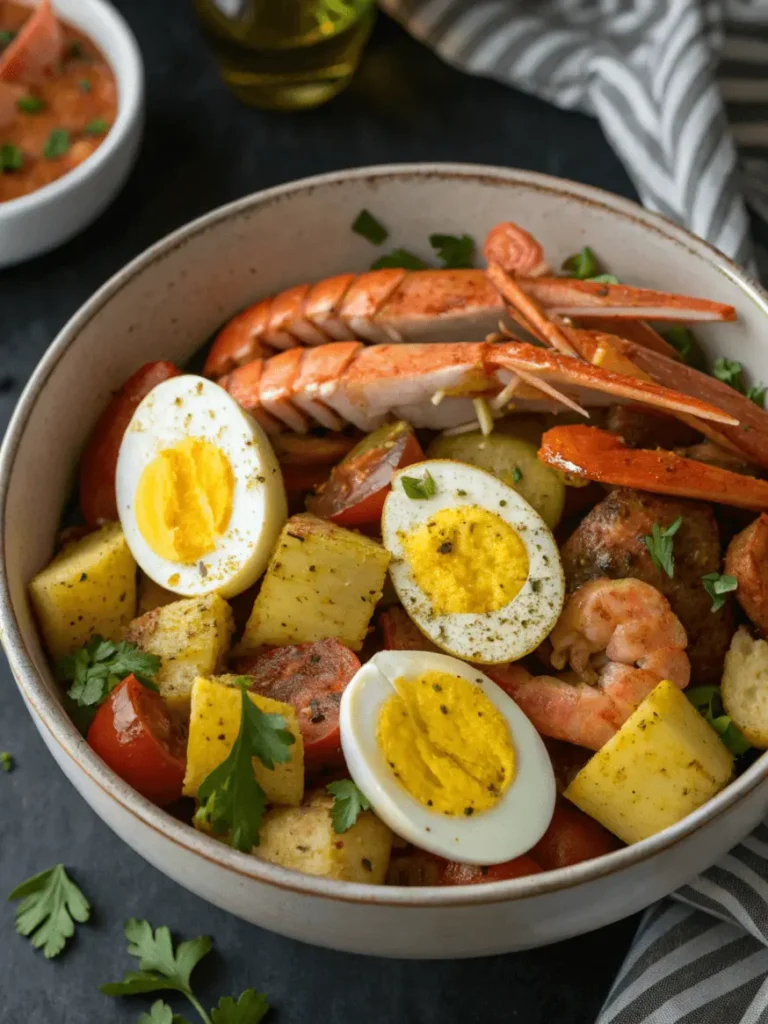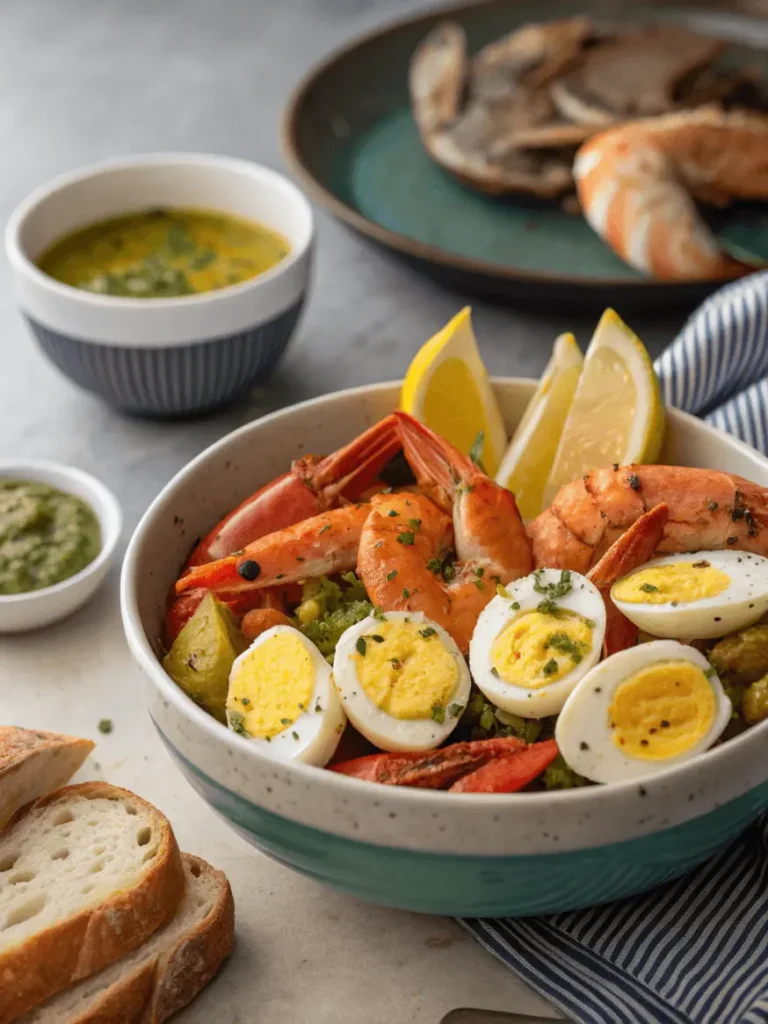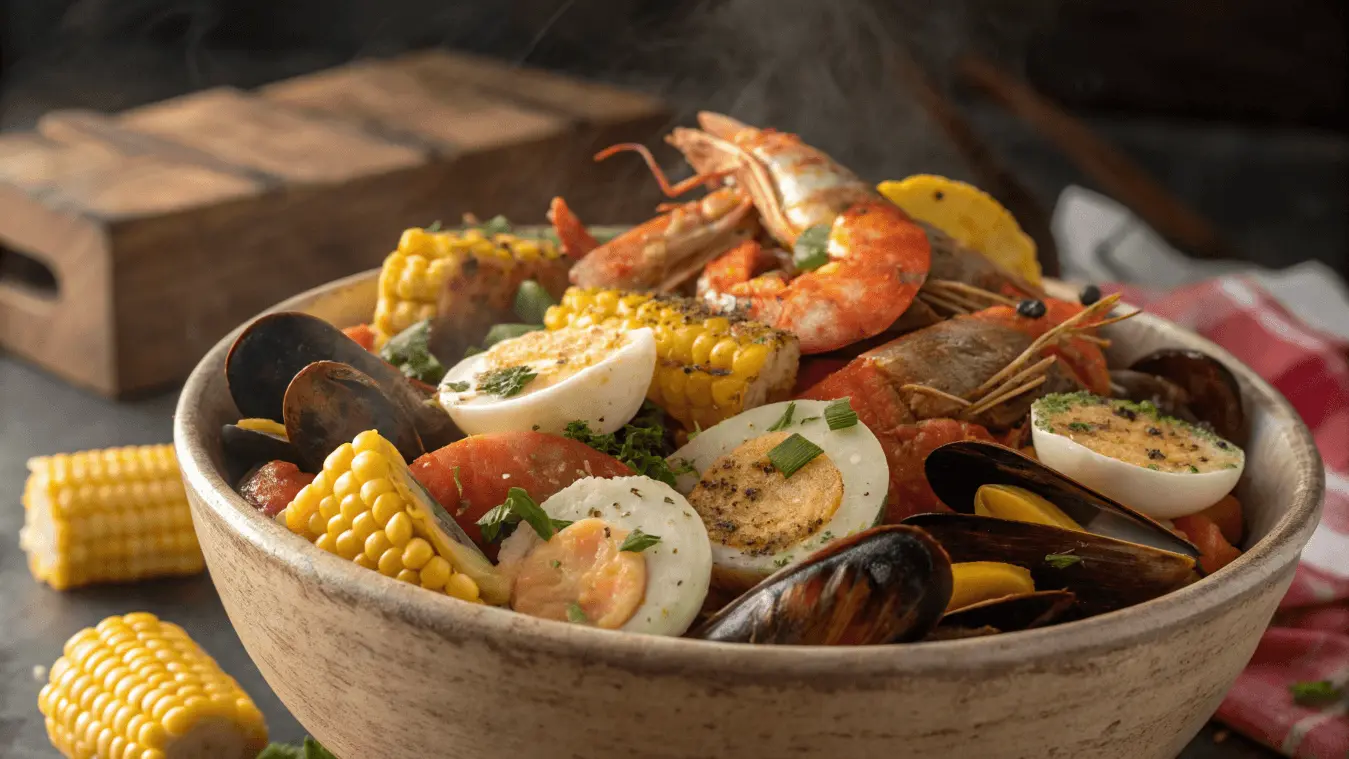Ever wondered, “Do you boil eggs before adding to a seafood boil?” If so, you’re not alone! Picture this: You’re preparing a mouthwatering seafood feast, your pot bubbling with bold Cajun flavors, juicy shrimp, and tender crab legs. Then, you remember the eggs—but wait! Should they go in raw, or should you boil them first? Making the right choice ensures your eggs soak up all the delicious spices while staying perfectly firm. No one wants rubbery eggs or, worse, a broken mess in the pot!
Now, imagine cracking open a perfectly seasoned egg, its creamy yolk infused with the rich, garlicky broth—it’s the ultimate seafood boil upgrade! Eggs aren’t just a tasty add-in; they balance the flavors and make your meal even more satisfying. Plus, they pair beautifully with that buttery dipping sauce. So, if you’re ready to master the perfect seafood boil, keep reading—we’ve got all the tips you need!
Table of Contents
Why Add Eggs to a Seafood Boil?

How Eggs Enhance Flavor and Texture
Adding eggs to a seafood boil may sound surprising, but it’s a game-changer! Eggs absorb the bold, spicy flavors of the broth, making every bite packed with seasoning. They also add a creamy, rich texture that balances the heat of Cajun spices. If you haven’t tried it yet, you’re in for a treat!
First, eggs soak up all the delicious flavors while they cook in the seasoned broth. The shells trap the spices, infusing the eggs with smoky, garlicky goodness. Once peeled, the egg whites hold a mild heat, while the yolk stays creamy and smooth. The contrast between the soft, buttery yolk and the slightly firm white makes every bite exciting.
Next, eggs act as the perfect companion to seafood. Shrimp, crab, and lobster bring a naturally sweet, briny taste. Eggs, on the other hand, add a rich, savory note. This mix of flavors makes your seafood boil even more satisfying. Plus, eggs are filling, making the meal heartier without overpowering the seafood.
Eggs also make seafood boils more fun to eat! Some people love cracking them open and dipping them in garlic butter or hot sauce. Others mix the yolk into the broth for extra thickness. No matter how you eat them, eggs bring a delicious twist to any seafood boil.
Here’s a quick breakdown of what eggs add to a seafood boil:
| Benefit | Why It Works |
|---|---|
| Flavor Absorption | Eggs soak up seasonings, making them flavorful inside and out. |
| Rich Texture | The creamy yolk adds contrast to the tender seafood. |
| Extra Heft | Eggs make the meal more filling without taking away from the seafood. |
| Dipping Potential | Hard-boiled eggs taste amazing with garlic butter or hot sauce. |
If you love bold flavors and exciting textures, adding eggs to your seafood boil is a must. The next time you prepare one, toss in a few eggs and see the difference for yourself!
Wondering what seafood is best for a boil? Check out this guide to perfecting your mix!
Popular Seafood Boil Variations That Include Eggs
Many seafood boil variations across different regions include eggs, and each one brings a unique twist. Whether it’s a traditional Cajun seafood boil or a Southern-style feast, eggs add extra heartiness and a new layer of flavor.
The most popular seafood boil with eggs comes from the Southern Cajun tradition. In Louisiana, seafood boils include shrimp, crab, corn, potatoes, and sausage substitutes. Many people add eggs to absorb the bold spices and provide a creamy bite alongside the heat. This method has become widely popular across the U.S.
Another variation comes from low-country boils, particularly in South Carolina and Georgia. These boils focus on shrimp, crab, corn, and potatoes. While eggs aren’t always included, they’re a delicious addition that many Southern families swear by. They pair perfectly with the classic mix of Old Bay seasoning, butter, and lemon.
Here’s a comparison of different seafood boil styles and how they incorporate eggs:
| Seafood Boil Type | Main Ingredients | Eggs Included? |
|---|---|---|
| Cajun Seafood Boil | Shrimp, crab, lobster, potatoes, corn, Cajun seasoning | Yes, absorbs bold flavors |
| Low-Country Boil | Shrimp, crab, potatoes, corn, Old Bay seasoning | Sometimes, adds richness |
| New England Clambake | Clams, mussels, lobster, potatoes, corn, butter | Rarely, but can be a unique addition |
| Texas Gulf Boil | Crawfish, shrimp, sausage, potatoes, corn, spicy broth | Yes, adds texture and flavor |
Another unique seafood boil that includes eggs is the Asian-style seafood boil. Popular in Vietnamese and Filipino cuisine, this boil features shellfish like shrimp, mussels, and crab, cooked in a rich, buttery garlic sauce. Hard-boiled eggs are often tossed in at the end, absorbing the flavorful broth while keeping their creamy texture.
Want to try a foolproof seafood boil recipe? Check out this easy seafood boil recipe and make your next feast unforgettable!
Should You Boil Eggs Before Adding Them to a Seafood Boil?
Pros and Cons of Pre-Boiling Eggs
Deciding whether to boil eggs before adding them to a seafood boil depends on the texture, flavor, and cooking convenience you prefer. Some people pre-boil their eggs to control doneness, while others cook them directly in the seafood pot for added flavor. Both methods work, but each has its pros and cons.
Pre-boiling eggs ensures they are fully cooked before going into the seafood boil. This method prevents undercooked yolks and makes peeling easier. It’s also great if you want eggs with a firmer texture. On the downside, eggs that are already cooked don’t absorb as much seasoning from the broth.
Cooking eggs directly in the seafood boil pot allows them to soak up bold flavors. The broth infuses the eggs with spices, making them extra delicious. However, timing is crucial—if added too early, the eggs can overcook, resulting in rubbery whites. If added too late, they may not cook through completely.
Here’s a quick comparison of both methods:
| Method | Pros | Cons |
|---|---|---|
| Pre-Boiling | Easier to peel, ensures full doneness, firmer texture | Less seasoning absorption |
| Cooking in Boil | Absorbs seasoning, rich flavor, saves time | Can overcook if left too long |
If you like eggs packed with spice, boiling them in the seafood pot is the way to go. But if you prefer perfectly cooked eggs with easy peeling, pre-boiling might be better. Either way, eggs bring an extra delicious bite to any seafood boil!
Best Cooking Methods for Adding Eggs to a Seafood Boil
Cooking eggs for a seafood boil can be done in different ways. The method you choose depends on whether you want a firm, mild egg or one bursting with flavor.
Top Ways to Cook Eggs for a Seafood Boil:
- Pre-Boil and Add Later: Boil eggs separately, then toss them in at the end to absorb flavor.
- Cook Directly in the Pot: Add raw eggs to the seafood boil and let them cook in the broth.
- Steam the Eggs First: Steaming gives a firmer texture and makes peeling easier.
- Use Soft-Boiled Eggs: These add a creamy, rich yolk texture to balance the spices.
For the best results, timing is key. If you cook eggs directly in the seafood boil, add them about 10-12 minutes before the seafood finishes cooking. This ensures a firm yolk without overcooking. If pre-boiling, cook the eggs separately for 8-10 minutes, then place them in the broth for the last few minutes to soak up the seasoning.
Here’s a quick guide on how long to cook eggs based on your method:
| Method | Cooking Time | Best Texture |
|---|---|---|
| Pre-Boiling | 8-10 minutes | Firm, easy to peel |
| Boiling in the Pot | 10-12 minutes | Rich, flavorful, slightly firmer |
| Soft-Boiling | 6-7 minutes | Creamy yolk, tender white |
| Steaming | 10 minutes | Firm yet moist |
Tips for Perfect Seafood Boil Eggs:
- Use older eggs – They peel easier after boiling.
- Add vinegar to the water – This helps shells come off smoothly.
- Shock in ice water – Prevents overcooking and makes peeling simpler.
- Add late in the boil – This keeps eggs from turning rubbery.
Choosing the best cooking method for seafood boil eggs depends on how much seasoning you want them to absorb. No matter which method you pick, adding eggs to a seafood boil makes it heartier and even more flavorful!
Step-by-Step Guide to Cooking Eggs in a Seafood Boil
Boiling Eggs Separately vs. Cooking Them in the Pot
When making a seafood boil, you can either boil eggs separately or cook them directly in the pot. Each method has its benefits, and the choice depends on your preferred texture and flavor.
Boiling eggs separately ensures they are perfectly cooked with an even texture. You control the doneness and prevent overcooking. Once boiled, they can be added to the seafood pot to absorb the rich flavors of the broth. This method also makes peeling easier, especially when eggs are placed in ice water after boiling.
Cooking eggs directly in the seafood boil gives them a bold, seasoned taste. As they cook, they absorb the Cajun spices, garlic, and butter from the broth. However, timing is key—leaving them in too long can make the yolks chalky. If you add them too late, they might not cook fully.
Here’s a comparison table for clarity:
| Method | Pros | Cons |
|---|---|---|
| Boiling Separately | Even cooking, easy peeling, controlled doneness | Less flavor absorption |
| Cooking in the Pot | Infused with seasoning, saves time | Can overcook, harder to peel |
For the best balance, many people boil eggs separately, then let them sit in the seafood broth for a few minutes. This way, they stay firm while soaking up the spices. If you love bold flavors, try cooking them directly in the pot!
How Long to Cook Eggs in a Seafood Boil for Best Results
Getting the perfect texture depends on timing. Overcooked eggs turn rubbery, while undercooked eggs won’t mix well with the seafood. The goal is to achieve firm yet creamy eggs that hold up in the boil.
Recommended Cooking Times:
- Soft-boiled eggs: 6-7 minutes – Creamy yolk, slightly firm white.
- Medium-boiled eggs: 8-9 minutes – Firmer yolk, great for absorbing seasoning.
- Hard-boiled eggs: 10-12 minutes – Fully cooked, ideal for dipping.
Tips for Perfectly Cooked Eggs in a Seafood Boil:
- Use a timer – Eggs cook quickly, so timing is crucial.
- Start with room-temperature eggs – This helps them cook evenly.
- Ice bath after boiling – Prevents overcooking and makes peeling easier.
- If cooking in the pot, add eggs 10-12 minutes before serving – This ensures they finish cooking without overboiling.
Here’s a quick reference table for cooking times:
| Egg Type | Boiling Time | Texture |
|---|---|---|
| Soft-Boiled | 6-7 minutes | Creamy yolk, delicate white |
| Medium-Boiled | 8-9 minutes | Slightly firm yolk, holds shape well |
| Hard-Boiled | 10-12 minutes | Fully cooked, best for seasoning |
By following these cooking times and tips, you’ll get perfectly seasoned, firm, and flavorful eggs in every seafood boil. Now, grab your pot and get ready to cook them just right!
Want to experiment with new flavors? Try this ground chicken chili recipe for a bold, protein-packed meal that complements a seafood boil!
Serving and Pairing Boiled Eggs in a Seafood Boil

Best Dipping Sauces for Seafood Boil Eggs
Dipping sauces take seafood boil eggs to the next level! Since eggs absorb bold flavors, pairing them with the right sauce makes every bite even better. Whether you love something buttery, spicy, or tangy, there’s a perfect sauce for your boiled eggs.
First, garlic butter sauce is a classic choice. It’s rich, smooth, and melts beautifully over eggs. Adding a touch of lemon juice makes it even more refreshing. If you love heat, spicy Cajun sauce is the way to go. Made with hot sauce, paprika, and a hint of honey, it balances spice and sweetness perfectly.
For something creamy, homemade aioli is a fantastic option. Blended with garlic, lemon, and a touch of mustard, it gives boiled eggs a smooth, tangy kick. If you prefer a smoky taste, chipotle mayo is an excellent choice. It pairs well with seafood while adding a mild heat.
Here’s a quick guide to the best dipping sauces for boiled eggs:
| Dipping Sauce | Flavor Profile | Best With |
|---|---|---|
| Garlic Butter Sauce | Rich, savory, slightly tangy | Classic seafood boils |
| Spicy Cajun Sauce | Bold, smoky, with a little heat | Eggs, shrimp, and crab |
| Lemon Herb Aioli | Creamy, zesty, slightly garlicky | Boiled eggs and shellfish |
| Chipotle Mayo | Smoky, slightly spicy, creamy | Pairs well with all seafood |
| Honey Mustard Sauce | Sweet, tangy, mildly spicy | Adds contrast to rich flavors |
Want an extra kick? Mix sauces together! Garlic butter and Cajun sauce create a buttery, spicy combo. Aioli and honey mustard blend sweetness with tanginess. Try different pairings and find your perfect match!
Creative Ways to Serve Boiled Eggs in a Seafood Feast
Boiled eggs are more than just a side—they can be the star of the show! Whether you mix them into your boil, slice them as a topping, or create a unique dish, there are plenty of creative ways to serve them.
Fun Ways to Serve Boiled Eggs in a Seafood Boil:
- Chop and mix into the seafood broth – This thickens the sauce and adds richness.
- Slice and place on top of the seafood – A great way to add a creamy element.
- Stuff with crab or shrimp salad – A flavorful twist on deviled eggs.
- Mash and blend into a spicy butter sauce – This creates a creamy dipping sauce.
- Toss into a seafood pasta dish – Perfect for adding protein and texture.
Want to get creative? Here’s a simple serving guide for boiled eggs in a seafood boil:
| Serving Style | How It Works | Best With |
|---|---|---|
| Whole Eggs in Boil | Absorbs seasoning, bold flavor | Classic Cajun seafood boils |
| Sliced Over Seafood | Adds creaminess, blends flavors | Crab, shrimp, and fish |
| Stuffed with Crab Salad | Fancy, flavorful, easy to eat | Lobster, shrimp, and mussels |
| Mashed into Sauce | Thickens butter sauce, adds richness | Spicy seafood dips |
| Mixed into Seafood Pasta | Adds protein, soft texture | Works well with garlic sauces |
Tips for the Best Egg Pairings in a Seafood Boil:
- Use seasoned boiled eggs – Let them soak in the seafood broth for maximum flavor.
- Pair with bold spices – Garlic, paprika, and lemon enhance the taste.
- Serve with fresh herbs – Chopped parsley or chives add freshness.
- Add eggs last – This keeps them from getting too soft or overcooked.
With the right dipping sauces and creative serving ideas, boiled eggs can be a standout addition to any seafood boil. Try different combinations, experiment with flavors, and make your seafood feast unforgettable!
Frequently Asked Questions (FAQs)
When boiling eggs do you put them in before the water boils?
It’s best to add eggs after the water starts boiling. First, bring the water to a rolling boil. Then, gently lower the eggs in with a spoon. This prevents cracking and ensures even cooking. Next, reduce the heat slightly and let them cook for the right time. Finally, transfer them to an ice bath to stop cooking and make peeling easier.
In what order should you do a seafood boil?
A seafood boil follows a simple order. First, boil water with seasoning, garlic, and lemon. Next, add potatoes since they take the longest to cook. Then, drop in corn and sausage substitutes. After that, add seafood like crab and shrimp, which cook quickly. If using eggs, add them 10 minutes before finishing. Finally, drain the pot, toss with butter, and enjoy!
Why do people eat boiled eggs with seafood?
Boiled eggs soak up seafood boil flavors, making them a delicious addition. They add a creamy texture that balances the bold spices. Plus, they pair well with garlic butter and Cajun seasoning. Eggs also make the meal more filling without overpowering the seafood. Whether dipped in sauce or mixed with broth, they bring extra richness to every bite. Try it once, and you’ll be hooked!
Why do people put salt in the water when boiling eggs?
Adding salt to boiling water helps in two ways. First, it prevents eggs from cracking by slightly strengthening the shells. Next, it makes peeling easier by loosening the membrane inside. Also, salt can help seal small cracks if they appear. Plus, if an egg leaks, the salt helps the whites solidify faster. A little salt goes a long way in perfecting boiled eggs!
Conclusion: Perfecting Your Seafood Boil with Eggs
Now you know the answer to ‘Do you boil eggs before adding to a seafood boil?’ The choice depends on your taste and cooking style. Pre-boiling eggs ensures firm texture and easy peeling, while cooking them in the pot enhances flavor. Either way, they make a delicious, filling addition.
First, decide how much seasoning you want the eggs to absorb. Next, choose the cooking method that works best for you. Then, pair your boiled eggs with bold dipping sauces to enhance every bite. Also, try creative serving ideas to make your seafood boil even more exciting.
Adding eggs to a seafood boil brings variety, richness, and fun to your meal. Whether you keep them simple or mix in extra flavors, they’re a game-changer. So, next time you prepare a seafood boil, toss in some eggs and enjoy the extra boost of flavor!


1 thought on “Do You Boil Eggs Before Adding to a Seafood Boil? Best Cooking Tips”